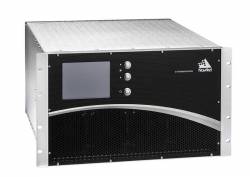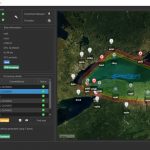Q: What is a virtual reference station and how does it work?
A: To reach centimeter-level — or even better — accuracy of positioning typically requires use of precise dual-frequency carrier phase observations. Furthermore, these observations are usually processed using a differential GNSS (DGNSS) algorithm, such as real time kinematic (RTK) or post-processing (PP). Regardless of the specific differential algorithm, however, implicit in the process is an assumption that the quality of the reference station data is consistent with the desired level of positioning accuracy.
The virtual reference station (VRS) concept can help to satisfy this requirement using a network of reference stations. As a quick review, a typical DGNSS setup consists of a single reference station from which the raw data (or corrections) are sent to the rover receiver (i.e., the user). The user then forms the carrier phase differences (or corrects their raw data) and performs the data processing using the differential corrections.
In contrast, GNSS network architectures often make use of multiple reference stations. This approach allows a more precise modeling of distance-dependent systematic errors principally caused by ionospheric and tropospheric refractions, and satellite orbit errors. More specifically, a GNSS network decreases the dependence of the error budget on the distance of nearest antenna.
The network of receivers is linked to a computation center, and each station contributes its raw data to help create network-wide models of the distance-dependent errors. The computation of errors based on the full network’s carrier phase measurements involves, first of all, the resolution of carrier phase ambiguities and requires knowledge of the reference station positions. (The latter is usually determined as part of the network setup.)
At the same time the rover calculates its approximate position and transmits this information to the computation server, for example, via GSM or GPRS using a standard National Marine Electronics Association (NMEA) format. The computation center generates in real time a virtual reference station at or near the initial rover position. This is done by geometrically translating the pseudorange and carrier phase data from the closest reference station to the virtual location and then adding the interpolated errors from the network error models.
This generated VRS data is then sent to the user through a wireless connection, often using the Networked Transport of RTCM via Internet Protocol (NTRIP). Finally, just as if the VRS data had come from a physical reference station, the rover receiver uses standard single-baseline algorithms to determine the coordinates of the user’s receiver, in near-real-time kinematic or post-processed modes.
The main purpose of a VRS station is to reduce the baseline distance between the rover and the reference station in order to efficiently remove spatially correlated errors using differential processing, and to incorporate error corrections obtained from the reference stations network.
To this end, the position of the VRS plays a critical role. In particular, because the user receiver cannot, by design, distinguish a real reference station and a VRS, the distance of the VRS from the user must be commensurate with the level of errors present in the VRS data. This is what allows the receiver to use its standard data processing algorithms, which vary as a function of the baseline length (i.e., distance) to the reference station.
To illustrate, let’s consider a simple example. Assume the user receiver performs L1-ony processing for baselines up to, say, 8 kilometers and wide-lane dual-frequency (L1/L2) combinations for longer baselines. (This is somewhat simplistic, but it serves our purpose here.)
Now, imagine if the errors in the VRS data were similar to a 20-kilometer baseline, but the VRS position was situated only 2 kilometers from the user. In this case, the user’s receiver would attempt to use L1-only processing, but the level of errors in the data would almost certainly not allow reliable results using this approach.
From this example we can see that the VRS concept basically needs the resource of a physical GNSS network surrounding the measurement area of the rover, with a minimum of three reference stations to enable the modeling of errors. However, the estimation accuracy increases as more physical reference stations are added to the network, especially as the number of stations exceeds five, at which point the increased redundancy and improved network geometry provide more accurate error modeling.
To conduct a survey employing a VRS network, the physical stations themselves must be installed over stable sites, preferably distributed homogeneously over the operational area. If possible, the antennas must be fixed in bedrock to ensure long term stability of the receiver’s position.
As an example, the Swiss Automated GNSS Network for Switzerland (AGNES) established by the Federal Office of Topography (swisstopo), which contains 30 stations with dual-frequency GPS/GLONASS receivers covering the entire 41,290-squarekilometer surface area of Switzerland. AGNES incorporates an additional 19 foreign stations with the data from all 49 sites processed together to generate VRS solutions for the whole of Switzerland. At any location an average length of 30 kilometers to the AGNES reference station is guaranteed across the country.
A difficulty in Switzerland is the height variation from the lowest point at 193 meters (above mean sea level) in Lake Maggiore to 4,634 meters on the peak of Monte Rosa. To best model the atmospheric errors, the stations should have similar altitudes because of the strong dependence of the troposphere error on receiver height. To this end, typically the Jungfrauhoch (JUJO) station is not integrated into the error modelling, because its elevation of 3,582 meters is too high in comparison with the other stations in the surrounding area.
Although the VRS approach generally provides an overall improvement relative to single reference station systems, it poses some challenges. First is a dependence of the VRS service on a communication system, such as the mobile phone network in the case of Switzerland (which is quite reliable).
Moreover this technique requires a bi-directional communication link between the receiver and the computation center, because the rover has to send information about its current position and has to receive the VRS data. This telecommunication link must provide high bandwidth communication between all the elements of system: the reference stations, the master control center, and the user receiver.
A second challenge is that errors can be generated by different tropospheric and stratospheric models applied between the computation center and the rover. Because the initial position provided by the rover to generate the VRS data is not usually precise, especially in height, the troposphere error computed by the network will not be perfect, with every 10 meters of initial height error yielding up to 0.2 millimeters of error from the troposphere model.
Fortunately, obtaining a 10-meter height error is quite reasonable in most applications involving carrier phase data, meaning the resulting troposphere modeling errors will usually be small.
Using the VRS technique, highly improved RTK positioning can be performed inside the network area. The precision of RTK positioning using VRS reaches two centimeters in the horizontal plane and four centimeters in the vertical direction (2σ).
The VRS concept allows a less dense antenna network without accuracy degradation because the multiple reference station network better models the spatially correlated GNSS errors over longer baselines. As a result the maximum distance between the rover and the nearest reference station can be extended in comparison with the typical 10 ~15 kilometers without accuracy degradation of the single reference station case.
Another benefit of a VRS is that the reference data are free of site-specific errors such as multipath, because the VRS computation assumes that the virtual station is situated at an ideal location. On the rover side the principal gains from the VRS principle are the use of common double-difference algorithms and the simplicity of computation, because the user does not need to perform any complex error modelling because this is being done already within the network.
Additional Resources
[1] Herbert L., and U. Vollath and X. Chen, “Virtual Reference Stations versus Broadcast Solutions in Network RTK –Advantages and Limitations,” paper presented at GNSS 2003 conference, April 2003, Graz, Austria (available here last accessed May 28, 2011)
[2] Hu, G. R., and H. S. Khoo, P. C. Goh, and C. I. Law, “Development and Assessment of GPS Virtual Reference Stations for RTK Positioning,” Journal of Geodesy, Vol. 77, p.292-302, 2003
[3] Retscher, G., “Accuracy Performance of Virtual Reference Station (VRS) Networks,” Journal of Global Positioning Systems, Vol.1, No.1:40-47, 2002 (available here last accessed May 22, 2011)
[4] Van Cranenbroeck J., and V. Lui and C. Rizos, “Ultimate Advance in GNSS RTK Monitoring Accuracy,” presented at the 7th FIG (International Federation of Surveyors) Regional Conference, Spatial Data Serving People: Land Governance and the Environment – Building the Capacity, 19-22 October 2009, Hanoi, Vietnam, (available here last accessed May 28, 2011)
Editor’s Note: VRS is a trademarked term of Trimble Navigation.





